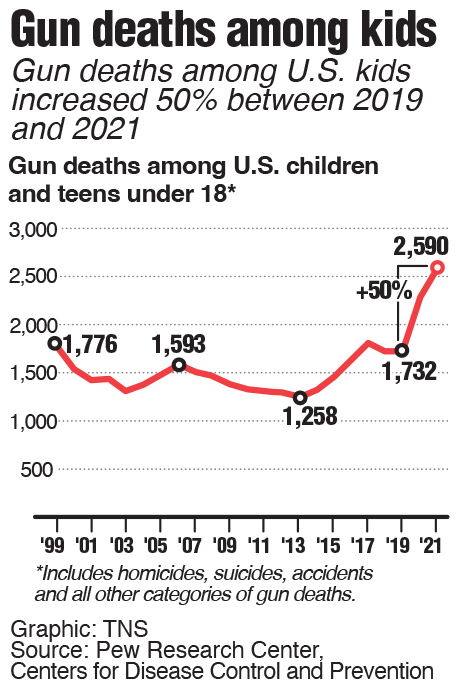ANN ARBOR, MI — New laws that strengthen safe storage of firearms and background checks on purchasers go into effect in early 2024 and are considered the most significant changes to gun safety measures in Michigan in nearly 30 years.
University of Michigan researchers provided evidence, including research and data on how the laws could save lives in and outside of the state. They helped legislators inform and craft language for the bills, which were signed into law by Gov. Gretchen Witmer on April 13, 2023.
Cynthia Ewell Foster is an associate professor of psychiatry at the U-M Medical School, clinical associate professor at the University Center for the Child and Family, and research associate professor at the Institute for Firearm Injury Prevention. She testified before legislative committees and can discuss the laws and implications in more detail.
What about this legislation strikes you most when it comes to children?
As a child clinical psychologist, I spend a lot of time thinking about the well-being of kids and families. Firearms are now the leading cause of death for children in the U.S. Since 2019, rates of firearm-related suicide and homicide have increased so significantly that for the first time, overall pediatric mortality has gone up instead of down. As a nation, we need to see this for what it is—a public health crisis impacting our children’s health and well-being.
When we store firearms more safely, we are reducing the risk of a child being injured or killed. Laws that require safe storage in homes where kids live have been shown to reduce unintentional injuries, homicides and suicides.
Estimates suggest that 13 million children in the U.S. reside in a home with at least one firearm. For 4.6 million children, those firearms are not securely stored, meaning they are stored loaded and/or unlocked. This is important because when we look at households where a child has been injured or killed by a firearm, the firearm in that child’s home was more likely to have been stored unlocked, loaded or with accessible ammunition nearby.
Together, these data suggest that safe storage or child access protection laws, such as the one just signed in Michigan, can make a significant lifesaving difference. There are many contributing factors to this problem and there won’t be one quick fix solution, but policy is one critical part of a comprehensive, evidence-based approach to reducing firearm injury and death.

Could you detail a bit more about the legislation and the evidence behind it?
Senate Bill 79 requires firearm owners to store their firearms in a locked container, such as a safe or lockbox, or unloaded with a locking device when there is a reasonable chance that a minor is or is likely to be on the premises. Although there are many firearm owners in the U.S. storing their firearms safely, survey data suggests that less than half of U.S. homes with firearms are storing their firearms securely. This bill reflects the evidence and data on access to firearms by children.
In a recent five-state study looking at who owned the firearm used in a youth suicide, 59% of the firearms were owned by parents, 20% by grandparents/extended family and another 20% by the youth themselves. We see a similar pattern in school shootings, where in 74% of cases, the shooter obtained the gun at home or from a family member. These studies underscore how important it is for all of the people in a child’s life to ensure that firearms in their household are not accessible to youth.
U-M’s Institute for Firearm Injury Prevention developed a helpful resource to help families to consider how they can improve their storage in a way that works for their family’s individual needs. Project Child Safe also has a wealth of resources for families.
Could you address the concerns of people worried about an erosion of their right to own a gun?
It’s important to remember all of the times we’ve been successful tackling public health issues in our country. These successes are possible when we work together and respect and embrace different ideas and approaches.
Our team at the University of Michigan has been working closely over the last several years with the Marquette County Health Department in Michigan’s Upper Peninsula and a community advisory board of firearm owners in that community. Teaching their children about respect for firearms and safe handling is a point of pride in this community where firearms are an important part of the culture.
Through these types of university-community partnerships, we can work together to ensure that data-driven injury prevention solutions are implemented in respectful and collaborative ways that honor individuals’ Second Amendment rights. Our children’s safety is something that all of us agree on, especially responsible firearm owners.
Another example of addressing a public health crisis with a collaborative, comprehensive approach, which our team at the Institute for Firearm Injury Prevention cites often, is the injury prevention science that cut U.S. motor vehicle deaths in half in the last few decades. A varied group of stakeholders worked together to make cars, drivers and the environment safer. I am optimistic that we can also do this with respect to firearm injury without eroding the rights of firearm owners.
Could you provide some additional data on deaths and injuries caused by firearms?
In 2021, which is the latest year for which data is available, we lost 1,544 Michiganders to a firearm-related death. Every year since 2011, we have lost more Michigan residents to firearms than to motor vehicle accidents.
We lose over 45,000 Americans each year to firearms, with mortality only being the tip of the iceberg. Many more individuals sustain injuries or experience the psychological impact of exposure to firearm violence. In young people, about 65% of firearm deaths are homicides, about 30% are suicides and about 3-4% are due to unintentional injuries.
I’d like to emphasize the role of firearm safety as a suicide prevention strategy. Firearms are responsible for over half of all suicide deaths in the U.S. Policies, such as background checks and safe storage laws like the ones going into effect next year in Michigan, make it more difficult for someone who is hurting to access a highly lethal means of ending their lives.
The data is clear that if a firearm is not available during a crisis, individuals are more likely to survive. When we follow up with survivors who attempted to end their lives, we see important messages of hope: 98% are still with us 25 years later; they did not go on to try to find another way to end their lives. Help is available and treatment works for people who are struggling with mental health concerns. If you are considering ending your life, please dial 988 to be connected with a caring supporter via phone.
If you are interested in learning more about suicide prevention in Michigan or finding a training so that you can be part of the safety net in your community, please visit the state of Michigan’s Suicide Prevention website.




